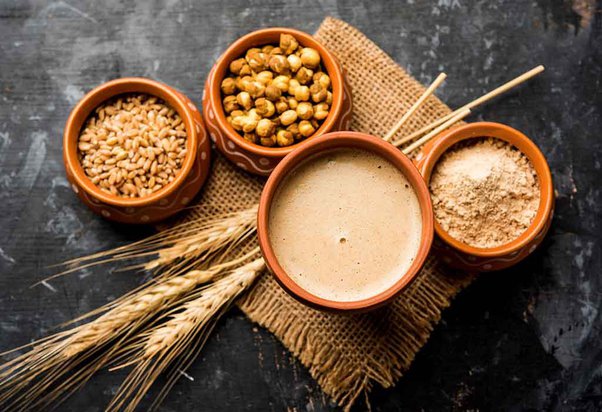Sattu, a staple in the diet of laborers and those on a budget, has gained attention for its potential role in weight gain and muscle building. Examining the physique of laborers from Bihar, Jharkhand, Madhya Pradesh, or West Bengal, who regularly consume sattu, reveals a lean yet robust structure. Traditionally considered “poor man’s food,” sattu proves affordable and nutritionally rich, meeting significant protein requirements for daily sustenance.
Sattu’s Role in Weight Gain and Muscle Building: Real-Life Insights
In the realm of fitness, sattu has historical ties to traditional workout spaces known as “akharas,” where bodybuilders incorporated it into their diets. The protein-rich composition of Bengal gram, the primary ingredient in sattu, establishes it as a suitable choice for individuals aiming for long-term goals such as muscle development and weight gain.
Sattu’s Nutritional Prowess for Muscle Building: A Balanced Perspective
Building muscle necessitates attention to protein quantity, quality, availability, and cost. Bengal gram sattu emerges as a commendable choice on all fronts. With 22.5g of protein per 100g and a biological value of 74, it offers a high-quality protein source. The cost-effectiveness of sattu, available year-round at an affordable price, further solidifies its position as a valuable dietary inclusion for muscle building.
While Bengal gram sattu lacks two sulfur-containing amino acids – Methionine and Cystine – essential for a protein to be considered “complete,” combining sattu with cereals in a 2:1 ratio remedies this deficiency. This combination creates a complete protein, ensuring a balanced amino acid profile essential for muscle development.
Comparing Bengal Gram Sattu with Protein Powders: Addressing the Discrepancy
Despite its nutritional richness, Bengal gram sattu contains less protein compared to animal or whey protein. A direct comparison reveals that whey protein, a popular supplement, boasts more than three times the protein content of Bengal gram sattu. However, the article emphasizes that the effectiveness of protein intake goes beyond sheer quantity. Whey protein’s concentrated form requires rigorous exercise for optimal utilization, and excessive reliance on supplements without adequate training may lead to potential health issues.
The article advises against blindly adopting the diets of athletes, models, or bodybuilders without considering individual lifestyles and exercise routines. It underscores the importance of choosing protein-rich foods like sattu, especially for regular office-goers and students aiming for overall nutrition and fitness.
Addressing Digestive Concerns: Debunking Myths Around Sattu
Some individuals associate sattu consumption with gas, acidity, or indigestion, attributing these issues to the food itself. However, the article reframes this perspective, suggesting that digestive discomfort indicates weak digestive capacity. Instead of blaming sattu, it encourages addressing overall dietary habits, avoiding refined sugars, flours, and oils present in processed foods. Additionally, promoting gut health through natural probiotics and prebiotics, including fermented preparations in the diet, can contribute to improved digestion.
The article concludes this section by offering a simple recipe for homemade sattu, emphasizing the benefits of soaking, germinating, and roasting to enhance nutritional availability and mitigate potential digestive issues.
Utilizing Sattu: From Porridge to Pre/Post-Workout Options
Sattu’s versatility allows for various consumption methods, from porridge with milk, bananas, nuts, and seeds to incorporating it into regular wheat flour for roti. While acknowledging sattu’s fiber content and slower digestion, the article suggests alternative options for post-workout drinks, such as raw beetroot juice for enhanced blood circulation and recovery. It recommends sattu as a pre-workout drink when mixed with water for increased energy during training sessions.
Determining Optimal Sattu Intake for Weight Gain and Muscle Development
Highlighting the need for a balanced diet, the article advises against relying solely on sattu for weight gain and muscle building. It stresses that sattu should complement other protein-rich foods, including pulses, nuts, seeds, and milk. Daily intake should align with individual digestion capacity, typically ranging from 30-40g. Emphasizing the importance of wholesome nutrition, the article emphasizes that achieving fitness goals requires a holistic approach, encompassing diet, exercise, rest, and mental well-being.
Protein Powders: Understanding Types and Benefits
Transitioning to the discussion on protein supplements, the article introduces various types of protein powders, including whey, casein, soy, pea, and hemp. Each type caters to specific dietary preferences, offering complete or complementary amino acid profiles. It delves into the health benefits associated with protein powder consumption, including weight management, muscle growth, recovery after exercise, and added nutrition.
Navigating Protein Powder Usage: Considerations and Caution
Before incorporating protein powders, the article advises individuals to calculate their nutritional needs, considering factors such as diet, exercise, and health status. It highlights potential risks associated with excessive protein consumption, including kidney and liver damage, bone and calcium balance issues, and potential nutrient imbalances. The article urges caution in selecting high-quality protein powder products from reputable suppliers due to concerns about heavy metal contamination.
Optimal Usage and Takeaway: Balancing Protein Powder Inclusion
The article addresses the ongoing debate on the optimal timing of protein supplementation, suggesting that it varies based on individual factors. While acknowledging conflicting research findings, it presents the general consensus that protein supplements can be beneficial after workouts.
In conclusion, the article reiterates the importance of a balanced approach to nutrition, emphasizing that protein powders are supplements, not replacements for a nutritious diet. It encourages individuals to seek guidance from healthcare professionals or dietitians before incorporating protein powders into their routines.

